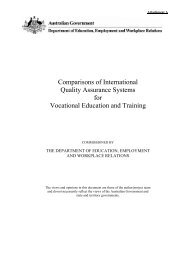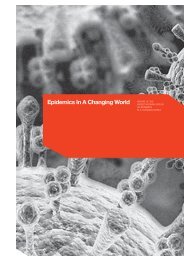National Survey of Research Commercialisation - Australian ...
National Survey of Research Commercialisation - Australian ...
National Survey of Research Commercialisation - Australian ...
You also want an ePaper? Increase the reach of your titles
YUMPU automatically turns print PDFs into web optimized ePapers that Google loves.
NATIONAL SURVEY OF RESEARCH COMMERCIALISATION<br />
HIGH SPEED WIRELESS LOCAL AREA NETWORKING<br />
The world standard for high-speed wireless local area networks, known as IEEE 802.11a<br />
and 802.11g, is based on CSIRO’s US Patent 5,487,609.<br />
In 1992, CSIRO commenced a Program for Local Area Networks and Services. Led by Dr<br />
John O’Sullivan, who now runs Cisco’s Wireless Networking R&D group in Sydney, up to<br />
20 staff investigated the features and system design requirements for high-speed wireless<br />
local area networks.<br />
CSIRO contracted Macquarie University to investigate, develop and do the detailed<br />
design <strong>of</strong> several key elements <strong>of</strong> the system including error coding and medium access<br />
control algorithms. In 1995 CSIRO subcontracted Macquarie University to design and<br />
build a prototype OFDM wireless modem chipset.<br />
When the chipset was near completion, Dr David Skellern and Dr Neil Weste, then<br />
with Macquarie University, established Radiata Pty Ltd., which licensed CSIRO’s<br />
Wireless LAN patent, OFDM modem design and ‘Parrot’ medium access controller<br />
under a non-exclusive license. A number <strong>of</strong> CSIRO staff joined the company, which was<br />
accommodated at the CSIRO Radiophysics laboratory in Marsfield, Sydney.<br />
Radiata attracted industry funding to further develop the chipset. In November 2001,<br />
Cisco acquired Radiata Pty Ltd for $US295 million — $A567 million in Cisco stock.<br />
The technology, which is embedded in silicon chips, can connect users within range <strong>of</strong><br />
their wireless network to almost anything, from television to business information. It can<br />
be used with almost any electronic device, from a laptop computer to a mobile phone to a<br />
video recorder or a household security system, all without expensive cabling. It can run at<br />
a blistering 54Mb per second, fast enough to even transmit video.<br />
Wireless technology currently has a range <strong>of</strong> about 100 metres. In a corporate setting,<br />
bases are set up on each floor at 100 metre distances to cover the whole <strong>of</strong>fice, connecting<br />
desktop and laptop computers, security devices, handheld organisers etc to the company<br />
network.<br />
The high speed wireless local area networking story is one that exemplifies the sort<br />
<strong>of</strong> results that can be achieved when CSIRO, and universities supported by the ARC,<br />
work together on research that is crucial to Australia’s future role in the important ICT<br />
industry.<br />
HORTICAL<br />
The last time you bought melons, nectarines, peaches or plums, you probably examined<br />
them, perhaps felt them for firmness, and dropped them in the plastic bag hoping the<br />
taste would live up to the appearance. It’s hit and miss.<br />
Now there is a way for producers to measure the sugar content <strong>of</strong> fruit without taking<br />
a chunk out <strong>of</strong> it, and to be able to guarantee sweetness. This is the result <strong>of</strong> a test<br />
54

















